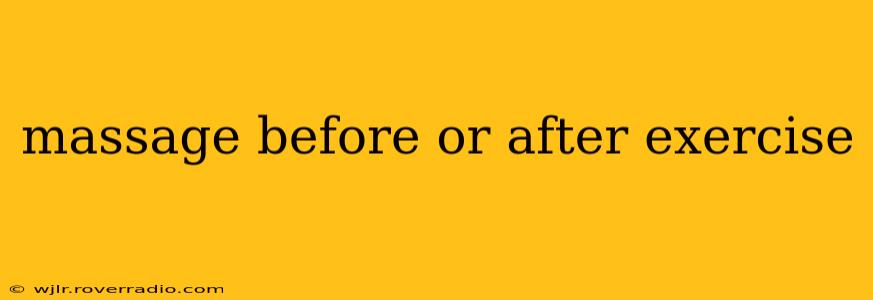Deciding whether to get a massage before or after your workout is a common question among athletes and fitness enthusiasts. The answer, however, isn't a simple "yes" or "no." The ideal timing depends largely on your fitness goals, the type of massage, and your individual needs. This comprehensive guide will explore the benefits of pre- and post-workout massage, helping you determine the best approach for your fitness routine.
Should I Get a Massage Before a Workout?
A pre-workout massage, often a lighter, shorter session focusing on specific muscle groups, can offer several advantages:
- Increased Range of Motion and Flexibility: A light massage before exercise can help loosen tight muscles and improve joint mobility, potentially leading to better performance and reduced risk of injury. Techniques like myofascial release can be particularly effective in improving flexibility.
- Improved Blood Flow: Massage stimulates circulation, delivering more oxygen and nutrients to your muscles. This can enhance muscle performance and reduce muscle fatigue during your workout.
- Reduced Muscle Tension and Anxiety: Some people find that a pre-workout massage helps to relax both physically and mentally, reducing pre-exercise anxiety and improving focus.
However, a pre-workout massage isn't always ideal. A deep tissue massage right before intense exercise could potentially cause muscle soreness or fatigue, hindering your performance. It's crucial to listen to your body.
Should I Get a Massage After a Workout?
Post-workout massage is generally recommended for its recovery benefits. It can help:
- Reduce Muscle Soreness (DOMS): Delayed-onset muscle soreness is a common experience after intense exercise. Post-workout massage helps to flush out lactic acid and other metabolic byproducts that contribute to soreness, speeding up recovery.
- Reduce Inflammation: Massage can help reduce inflammation in muscles and tissues, minimizing damage and promoting faster healing.
- Improve Circulation and Lymphatic Drainage: Just as with pre-workout massage, post-workout massage improves circulation, aiding in the removal of waste products and the delivery of oxygen and nutrients to repairing tissues.
- Prevent Muscle Stiffness and Tightness: Regular post-workout massage can help prevent the development of chronic muscle stiffness and tightness, improving flexibility and overall well-being.
The type of massage after a workout is important. A deeper tissue massage may be more beneficial for addressing muscle soreness than a lighter sports massage.
What Type of Massage is Best Before and After Exercise?
The type of massage best suited to you depends on your individual needs and fitness goals. However, here's a general guide:
- Pre-workout: A light sports massage, focusing on dynamic stretching and improving blood flow, is usually recommended. Avoid deep tissue massage before a workout.
- Post-workout: Sports massage, deep tissue massage, or even self-massage techniques like foam rolling can be beneficial. The intensity should be adjusted based on the intensity of your workout and your individual tolerance.
How Often Should I Get a Massage for Exercise Recovery?
The frequency of massage for exercise recovery varies depending on your training volume and intensity. Athletes involved in high-intensity training might benefit from more frequent massages, potentially once or twice a week, while individuals with less intense workouts might only need a massage once a month or less.
Can I Use Self-Massage Techniques?
Yes! Self-massage techniques like foam rolling, using a massage ball, or even using your hands to massage your muscles are excellent ways to supplement professional massage and aid in recovery. These techniques can be used both pre- and post-workout, focusing on areas that feel tight or sore.
What are the potential drawbacks of massage before or after exercise?
While massage generally offers many benefits, there are potential drawbacks to consider:
- Increased muscle soreness (pre-workout): A deep tissue massage before exercise could paradoxically worsen soreness.
- Bruising or discomfort: Deep tissue massage can sometimes cause temporary bruising or discomfort.
- Cost: Professional massage can be expensive.
Ultimately, the decision of whether to get a massage before or after exercise is a personal one. Experiment to find what works best for your body and fitness goals. Always listen to your body and consult with a healthcare professional or qualified massage therapist if you have any concerns.
